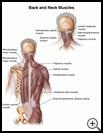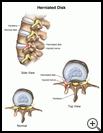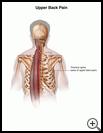
Back Pain Discharge Information
What is back pain?
The spine is made up of a group of bones in your back called vertebrae, which protect the spinal cord. Each vertebra has several bones, muscles, and ligaments to help keep the vertebrae in their proper position. Ligaments are strong bands of tissue that connect one bone to another to form the joints. In between the vertebrae are gel-like shock absorbers called disks. Nerves that lead to the body pass between the layers of vertebrae bones.
Vertebrae are named based on where they are located in the back. Cervical vertebrae are found in the neck, thoracic vertebrae in the upper back, and lumbar vertebrae in the lower back. The sacrum is below the lumbar vertebrae and is made up of 5 fused bones. Below that, your tailbone is made up of 3 fused bones called the coccyx.
Back pain may be caused by:
- Injuries or overuse, which most often affects muscles, joints and ligaments
- Poor posture
- Being overweight
- Poor body mechanics when lifting
- Pressure on spine nerves, due to:
- Disk thinning or rupture, causing loss of space between the vertebrae
- Narrowing of the spinal canal by abnormal bone growth, or osteoarthritis
- Osteoporosis, which is thinning and weakening of the bones
- Any bone fracture in the vertebrae bones
- Structure problems you were born with, such as scoliosis
- Infection
- Tumors
- Movement of the gel disc from between the vertebrae, or subluxation
How can I take care of myself when I go home?
How long it takes to get better depends on the cause of your back pain, your treatment, how well you recover, your overall health, and any complications you may have.
Management
- Your provider will give you a list of your medicines when you leave the hospital.
- Know your medicines. Know what they look like, how much you should take each time, how often you should take them, and why you take each one.
- Take your medicines exactly as your provider tells you to.
- Carry a list of your medicines in your wallet or purse. Include any nonprescription medicines and supplements on the list.
- Talk to your provider before you use any other medicines, including nonprescription medicines.
- Your provider may prescribe medicine to:
- Treat pain
- Treat or prevent an infection
- Reduce swelling
- Treat or prevent side effects, such as nausea or constipation, from other treatments
- Your provider may recommend other types of therapy to help relieve pain, other symptoms, or side effects of treatment.
- You may need to continue a rehabilitation program after you leave the hospital to help you recover from back pain and its treatment. Most rehabilitation programs include:
- Physical therapy to help you regain muscle strength and teach you ways to move safely
- Occupational therapy to help you learn safe ways to do the tasks that you did before your back pain started
- If your nerves are damaged and you have trouble with your bowel or bladder, therapy may include skin, bladder, and bowel care and training.
- If you have had surgery, to care for your surgical wound:
- Keep your surgical wound clean.
- If you are told to change your dressing on your surgical wound, wash your hands before changing the dressing and after disposing of the dressing.
- Follow activity restrictions, such as not driving or operating machinery, as recommended by your healthcare provider or pharmacist, especially if you are taking pain medicines or muscle relaxants.
- Take care of your health. Try to get at least 7 to 9 hours of sleep each night. Eat a healthy diet and try to keep a healthy weight. If you smoke, try to quit. If you want to drink alcohol, ask your healthcare provider how much is safe for you to drink. Learn ways to manage stress. Exercise according to your healthcare provider's instructions.
Appointments
- Follow your provider's instructions for follow-up appointments.
- Keep appointments for any testing you may need.
Talk with your provider about any questions or concerns you have.
Call emergency medical services or 911 if you have new or worsening:
- Back pain with numbness, tingling, pain, or weakness in one or both legs or arms
- Loss of bladder or bowel control
- Trouble with muscle movements, such as moving arms and legs
Do not drive yourself if you have any of these symptoms.
Call your healthcare provider if you have new or worsening:
- Back pain
- Depression
- Lightheadedness
- Loss of balance or coordination
- Changes in bladder or bowel control
- Numbness in your legs, feet, arms, or hands
- If you had surgery, signs of infection around your surgical wound. These include:
- The area around your wound is more red or painful.
- Your wound area is very warm to touch.
- You have blood, pus, or other fluid coming from the wound area.
- You have a fever higher than 101.5° F (38.6° C).
- You have chills or muscle aches.
- Swelling in your legs, ankles, or feet
Last modified: 2015-12-21
Last reviewed: 2015-12-21




